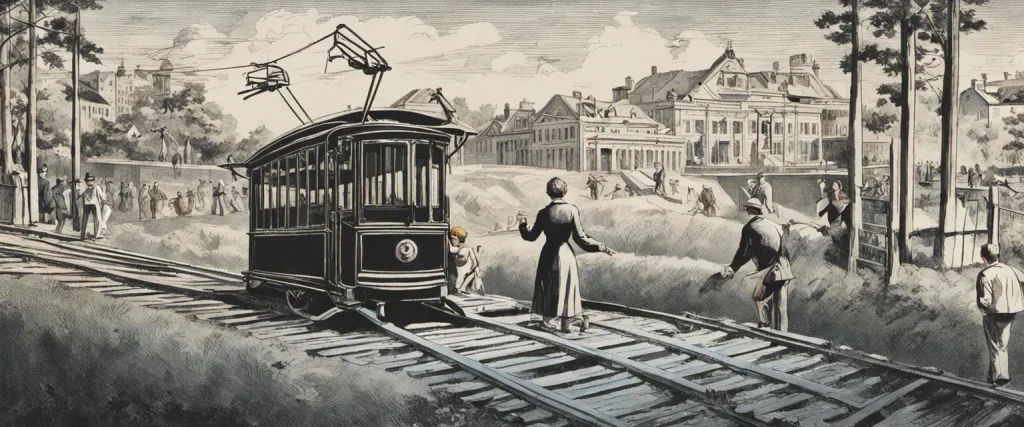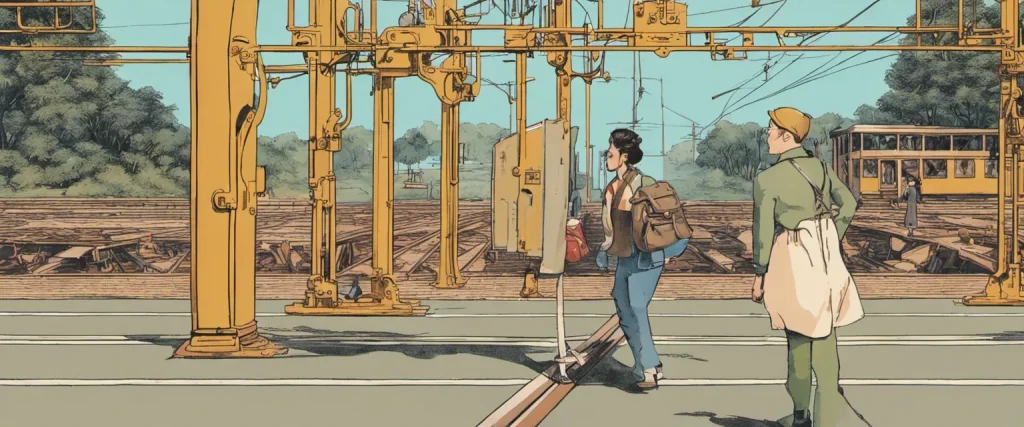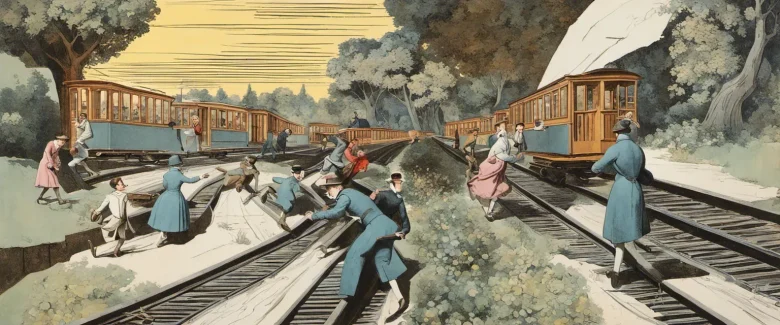In “The Trolley Problem” by Thomas Cathcart, a thought-provoking exploration into moral dilemmas, the author invites readers to enter the realm of ethical decision-making. Through captivating anecdotes and insightful analysis, Cathcart challenges conventional thinking and compels us to question our moral compass. A seasoned philosopher and co-author of the bestselling “Plato and a Platypus Walk into a Bar,” Cathcart skillfully blends wit with intellect, making complex ethical quandaries accessible and relevant to readers of all backgrounds. Embark on a journey of moral introspection and join Cathcart in grappling with the intricacies of ethical choices in a world filled with competing interests and divergent perspectives.
Chapter 1: Introduction
Chapter 1: Introduction of the book “The Trolley Problem” by Thomas Cathcart presents an engaging exploration of a renowned ethical thought experiment. Cathcart introduces readers to the concept of the trolley problem, a hypothetical situation widely used in moral philosophy to discuss moral dilemmas and the principle of utilitarianism. The chapter aims to familiarize readers with the problem and lay the groundwork for further exploration.
Cathcart begins by posing the scenario of a runaway trolley heading toward a group of five people tied to the tracks, with no possibility of stopping it. However, there is a lever that can divert the trolley onto a separate track, where only one person is tied. This thought experiment forces individuals to grapple with the moral implications of choosing between minimizing overall harm by sacrificing one life or adhering to the principle that taking a life is inherently wrong.
The author provides various real-life examples of the trolley problem to illustrate its relevance beyond theoretical discussions. Cases involving self-driving cars and organ transplantation present complex situations where ethics and consequential decision-making are vital.
Cathcart outlines the different ethical frameworks that individuals may adopt when analyzing the trolley problem. Utilitarianism, the belief in maximizing overall happiness, suggests that one should divert the trolley to minimize the overall loss of life. Conversely, some argue for the primacy of individual rights, asserting that taking any life, regardless of the outcome, is morally wrong.
The chapter concludes by recognizing the significance of the trolley problem in raising fundamental questions about ethics, moral absolutes, and the utilization of reason to make ethical judgments. Cathcart’s thought-provoking Introduction sets the stage for the subsequent exploration of the trolley problem throughout the book, challenging readers to examine their own ethical beliefs and moral reasoning.
Chapter 2: The Trolley Problem
Chapter 2 of “The Trolley Problem” by Thomas Cathcart delves into the famous ethical dilemma known as the Trolley Problem. The author introduces the thought experiment which involves a runaway trolley hurtling down a track, with five people tied to the tracks ahead. The reader is then presented with the option to either do nothing and allow the trolley to kill the five people, or to pull a lever diverting the trolley onto another track where only one person is tied. The decision becomes morally challenging as it raises questions about the value of life and the ethics of choosing between the lesser of two evils.
Cathcart explores various scenarios and interpretations of the Trolley Problem, highlighting its real-world implications for moral philosophy. He delves into the distinction between action and inaction, suggesting that actively pulling the lever to kill one person may be seen as more morally permissible than passively allowing five people to die. However, the author acknowledges the complexity of the situation, as some argue that taking an active role in causing someone’s death is tantamount to killing them, regardless of the greater good.
Furthermore, the chapter considers additional factors that may influence one’s decision-making, such as personal responsibility, proximity to the situation, and cultural differences. Cathcart also introduces the speculative notion of self-driving cars, which might one day face a similar moral dilemma where they have to make split-second decisions about who to protect in potentially fatal situations.
As Chapter 2 concludes, the author emphasizes the difficulty and ambiguity of the Trolley Problem, pointing out that it serves as a case study for exploring the complexities of moral decision-making. The ultimate goal is to understand the challenging trade-offs between saving more lives or preserving certain principles and ethical values.
Chapter 3: Utilitarianism and the Trolley Problem
Chapter 3 of the book “The Trolley Problem” by Thomas Cathcart explores the concept of utilitarianism and its application to the famous ethical dilemma known as the Trolley Problem. Utilitarianism, as developed by philosophers like Jeremy Bentham and John Stuart Mill, is based on the principle that the moral worth of an action is determined by its overall utility or ability to maximize happiness and minimize suffering for the greatest number of individuals.
In the context of the Trolley Problem, the scenario involves a runaway trolley hurtling down a track towards five people who are in its path. The protagonist has the choice to take a lever that diverts the trolley to another track, but this alternative track features a single person who will be killed if the trolley is redirected. This thought experiment forces individuals to confront the ethical trade-offs between saving a greater number of lives at the expense of an innocent individual’s life.
Utilitarians argue that in this situation, the morally correct action is to pull the lever and redirect the trolley towards the single person. Their reasoning is grounded in the belief that by sacrificing one life, they can save five lives and maximize overall happiness or satisfaction. This decision aligns with the utilitarian principle of “the greatest good for the greatest number.”
Cathcart delves deeper into the complexities of utilitarianism, acknowledging that the Trolley Problem brings to light the fundamental tensions between our intuitions and the utilitarian calculations. The chapter highlights various criticisms and counterarguments against utilitarianism, such as objections that it fails to value individual rights, that it treats people as mere means to an end, or that it ignores the significance of personal relationships and emotions.
Overall, Chapter 3 explores the application of utilitarianism to the Trolley Problem, diving into the nuances and challenges that arise when attempting to apply a purely utilitarian approach to ethically complex scenarios.
Chapter 4: Deontology and the Trolley Problem

Chapter 4 of “The Trolley Problem” by Thomas Cathcart explores the ethical theory of deontology in relation to the well-known moral dilemma called the trolley problem. Deontology is a moral philosophy that focuses on the duties and obligations of individuals when making ethical decisions.
The chapter begins by introducing the trolley problem scenario, where a train is heading towards five people tied to the tracks, and you have the choice to divert it onto a separate track where only one person is present. Deontologists argue that our moral duty is to follow certain rules and principles regardless of the consequences. In this case, deontologists would argue against diverting the trolley because they believe killing is inherently wrong, regardless of the number of lives saved. They prioritize following the moral rule of not intentionally causing harm.
Cathcart further explores different perspectives within deontology by introducing the idea of the Doctrine of Double Effect. This doctrine distinguishes between intending harm as an end in itself and causing harm as a foreseeable consequence while intending a greater good. Deontologists who adhere to this doctrine may argue that it is permissible to divert the trolley because the intention is to save five lives, even though one life is sacrificed.
The chapter also considers objections to deontological approaches, including the argument that deontologists emphasize the strict adherence to rules at the expense of overall consequences. Utilitarians, for example, would argue that maximizing overall happiness by sacrificing one person’s life to save five is the morally correct choice.
Overall, Chapter 4 delves into the complex considerations and perspectives of deontological ethics and how they intersect with the trolley problem scenario. It prompts readers to critically evaluate the fundamental principles and duties that guide their own moral decision-making.
Chapter 5: The Role of Intentions
Chapter 5 of “The Trolley Problem” by Thomas Cathcart explores the pivotal role of intentions in ethical decision-making. The chapter delves into the question of whether consequences or intentions should determine the moral worth of an action.
Cathcart begins by introducing the classical doctrine of double-effect, which states that an action is morally permissible if the agent intends a good outcome while foreseeing an accompanying bad consequence. He presents various scenarios to illustrate this concept, such as a doctor performing surgery that could save a patient’s life but might result in their death. The doctor’s intention to save the patient is deemed morally acceptable, even though the death remains a foreseen consequence.
However, Cathcart argues that the doctrine of double-effect fails to provide a comprehensive solution to ethical quandaries. He suggests that the intention behind an action plays a central role in determining its moral worth. He proposes a different thought experiment known as “The Footbridges,” where a person’s intention to push an innocent bystander onto a train tracks to save five others is brought into question. The intentional act of harm is considered morally unacceptable to many, even if the consequences might be favorable.
Cathcart also explores the concept of blame, distinguishing between someone who causes harm without intending it and someone who intentionally causes harm. If someone’s actions result in harm unintentionally, they may be subject to guilt but not blame. However, intentionality carries greater moral implications, as it indicates a closer connection to the harm caused.
In conclusion, Chapter 5 of “The Trolley Problem” highlights the significance of intentions in ethical decision-making, emphasizing that they should not be overlooked when evaluating the moral worth of an action. Cathcart challenges the notion that consequences alone should determine the moral permissibility of an action and invites readers to critically examine the intentions behind their own choices and actions.
Chapter 6: Moral Dilemmas and Ethical Reasoning
Chapter 6 of “The Trolley Problem” by Thomas Cathcart explores moral dilemmas and ethical reasoning. The chapter delves into the complexities of decision-making when faced with ethical predicaments by analyzing various thought experiments and philosophical perspectives.
The chapter begins by examining the infamous Trolley Problem, where a person must decide whether to pull a lever that diverts a runaway trolley towards one person, potentially saving five others in the process. Cathcart investigates the different intuitions people have in this scenario, highlighting the conflicting ethical principles that guide our moral decision-making.
Next, Cathcart addresses the idea of consequentialism, which argues that the consequences of an action determine its moral value. He discusses the utilitarian viewpoint that promotes actions that maximize overall happiness or minimize suffering, which can sometimes lead to morally challenging decisions.
Cathcart then explores deontology, an ethical theory that emphasizes following rules or duties irrespective of their consequences. He discusses philosopher Immanuel Kant’s categorical imperative, stating that moral actions should be guided by universal principles. Cathcart also examines duty conflicts, where one may face conflicting obligations, leading to ethical dilemmas.
Furthermore, the chapter delves into virtue ethics, which focuses on one’s character and habits. Cathcart explains that virtuous individuals tend to make ethical decisions more naturally by embodying virtues such as compassion, honesty, and justice.
Moreover, the chapter discusses various ethical frameworks, including rights-based theories and care-based ethics, in addition to exploring the role of empathy in ethical reasoning.
In summary, Chapter 6 of “The Trolley Problem” delves into moral dilemmas and ethical reasoning, examining the conflicting principles and perspectives that guide decision-making in challenging ethical situations. The chapter explores consequentialism, deontology, virtue ethics, and other ethical frameworks, ultimately highlighting the complexities involved in making moral choices.
Chapter 7: Critiques and Counterarguments
In Chapter 7 of the book “The Trolley Problem” by Thomas Cathcart, the author delves into the various critiques and counterarguments surrounding the well-known ethical dilemma. The trolley problem is a thought experiment that presents individuals with a moral decision involving a runaway trolley, where they have to decide whether to pull a lever and redirect the trolley to save five people at the expense of one.
Cathcart starts by acknowledging the criticism that the trolley problem is an unrealistic and artificial scenario, as it simplifies complex moral decision making. However, he argues that despite its artificiality, the thought experiment is still valuable in exploring ethical reasoning and encouraging discussions.
Another critique discussed is the objection that the trolley problem places too much emphasis on utilitarianism, the ethical theory that promotes the greatest good for the greatest number. Some critics argue that it neglects other important ethical considerations such as individual rights and duties. Cathcart counters this by highlighting the importance of deliberation and considering multiple ethical frameworks when making decisions.
Furthermore, some philosophers argue that the trolley problem fails to capture the real-life complexities of moral decision making. It is a controlled and isolated scenario that doesn’t account for the uncertainty or emotional factors that play a significant role in ethical dilemmas. Cathcart acknowledges this argument and suggests that the trolley problem serves as a starting point for further exploration rather than a comprehensive examination of all possible scenarios.
In conclusion, Chapter 7 of “The Trolley Problem” discusses common critiques and counterarguments related to the ethical dilemma presented in the book. It addresses concerns about the scenario’s artificiality, the dominance of utilitarianism, and the simplification of real-life moral decision making. Cathcart recognizes these critiques but emphasizes the value of the thought experiment in stimulating ethical discussions and raising awareness of the complexities involved in moral choices.

Chapter 8: Conclusion
Chapter 8: Conclusion of the book “The Trolley Problem” by Thomas Cathcart provides a thoughtful and contemplative wrap-up to the ethical dilemma presented throughout the book.
The chapter begins by highlighting the importance of acknowledging and accepting the existence of ethical questions in our lives. Cathcart emphasizes that these questions are not mere hypothetical exercises but have practical implications for our daily moral choices. He suggests that understanding the intricacies of ethical problems can lead to better decision-making and a more thoughtful approach to life.
Cathcart then delves into the different perspectives that have been explored throughout the book. He revisits the contrasting ethical principles of consequentialism and deontology, which respectively prioritize the outcome and the duty in ethical decision-making. He acknowledges that there are merits to both approaches and that each can offer valuable insights.
Furthermore, Cathcart acknowledges the limitations of ethics and the lack of definitive answers to many moral dilemmas. He contends that ethical discussions are essential in order to navigate the complexities of life, but they may not always provide conclusive resolutions. He encourages readers to embrace the uncertainty and engage in ongoing conversations to continuously refine their understanding of ethics.
Ultimately, the chapter serves as a reminder that ethical dilemmas are not easily solved and often require careful considerations from multiple perspectives. It encourages readers to think critically, discuss, and cultivate a sense of empathy towards others when navigating moral challenges. By doing so, Cathcart argues, individuals can strive to make more informed and morally conscious decisions, ultimately leading to a more ethical society.
After Reading
In conclusion, Thomas Cathcart’s book, The Trolley Problem, provides a thought-provoking exploration of moral dilemmas and ethical decision-making through the lens of the well-known philosophical scenario. Cathcart presents various perspectives and arguments, delving into the complexities and ethical implications of these hypothetical scenarios. By engaging readers in a captivating and accessible manner, the book challenges individuals to critically evaluate their own moral values and the potential consequences of their choices. Overall, The Trolley Problem serves as a compelling read for those interested in philosophy, ethics, and the perplexing nature of moral decision-making.
1. “Ethics” by Simon Blackburn: This book offers a comprehensive and accessible introduction to the field of ethics. Blackburn explores various ethical theories, including consequentialism, deontology, and virtue ethics, while engaging with real-life examples and thought-provoking dilemmas. With clear explanations and philosophical rigor, Blackburn encourages readers to reflect on their own moral beliefs and develop a well-reasoned ethical framework.
2. “Many Lives, Many Masters” by Brian L. Weiss: The book recounts the journey of Weiss as he initially approaches Catherine’s therapy from a traditional psychiatric perspective but later discovers that her symptoms and traumas may be rooted in past life experiences. Through hypnosis and regression therapy, Weiss guides Catherine through a series of sessions where she recalls memories from her previous lifetimes.
3. “Practical Ethics” by Peter Singer: Singer addresses pressing ethical issues in this foundational book. Exploring topics such as animal rights, euthanasia, and global poverty, Singer urges readers to consider the ethical implications of their choices and actions. By blending philosophy with practical examples, he encourages a more compassionate and ethically responsible approach to decision-making. This book empowers readers to engage with ethical challenges present in today’s world.
4. The Tipping Point” by Malcolm Gladwell: Although not directly related to ethics, this book offers valuable insights into social dynamics that can influence our ethical decision-making. Gladwell explores the factors contributing to societal changes, such as the spread of ideas, behaviors, and trends. The book is filled with fascinating case studies and thought-provoking anecdotes, making it an engaging read for anyone interested in understanding how small actions can have significant ethical ramifications.
5. “The Moral Landscape” by Sam Harris: This provocative book challenges traditional notions of morality by advocating for a more scientific approach. Harris argues that moral values can be objectively understood through scientific inquiry, grounding ethics in empirical evidence. By combining philosophy with neuroscience and evolutionary biology, Harris prompts readers to reconsider the foundations of morality and the possibility of an objective moral landscape. This book will undoubtedly provoke lively discussions on the nature of ethics.



